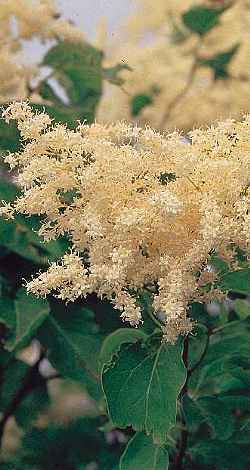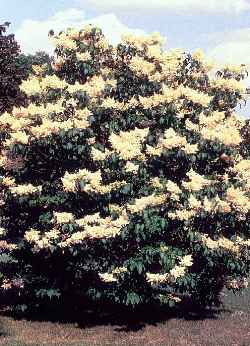
Syringa reticulata, Herman, D.E. et al. 1996. North Dakota tree handbook. USDA NRCS ND State Soil Conservation Committee
Sunset®: 1-12, 14-16
USDA: 3-8b
Heat Tolerance: Doesn't like warm climates
Sun Exposure: Full sun
Origin: Northern Japan
Growth Habits: Deciduous large shrub or small tree, 20 to 30 feet tall (6-9 m); cherry-like bark; simple, dark green, opposite, entire leaves 2 to 5 inches long (5-12 cm)
Watering Needs: Regular water
Propagation: Cuttings, seeds
Propagation: Seed or occasionally cutting, layering, grafting/budding,
- by softwood, semi-hardwood stem tip cuttings, in spring. Apply IBA TALC 8000 PPM. Use intermittent mist. Root in 4-6 weeks. Best time to take lilac cuttings is when the terminal bud in unfoldingand the joint with the main stem is somewhat sticky..
- by trench layers, in late autumn.
- by whip, 'T', side graft grafts, in late summer. Use a S. vulgaris or ligustrum ovalfolium as graftstock. S. vulgaris rootstock is more compatible but it has more suckers, on the other hand budding on privet should be done below the normal soil level to allow the lilac to establish its own roots.
- by seeds, in spring. The seeds can be harvested in autumn. The seeds need stratify 40F 2-3mo..

Syringa reticulata, Herman, D.E. et al. 1996.
Blooming Habits:
Showy, fragrant (found unpleasant by many), off-white flowers, in early summer, in large terminal panicles, up to 12 inches long (30 cm), 10 inches wide (25 cm)
Culture:
The tree lilacs bloom on the previous year wood. Pruning should be done after the blooming is finished. They transplant easily.
Desert-Tropicals is dedicated to provide gardening advice, gardening ideas, and information about flower of all kind for landscape and collections.We try to check carefully the identification of the plants on the illustrations as well as the other information from the page, but occasionally errors do occur. if you notice anything that needs to be changed please contact us.Thanks.
© 1998-2020 Philippe Faucon, All Rights Reserved.